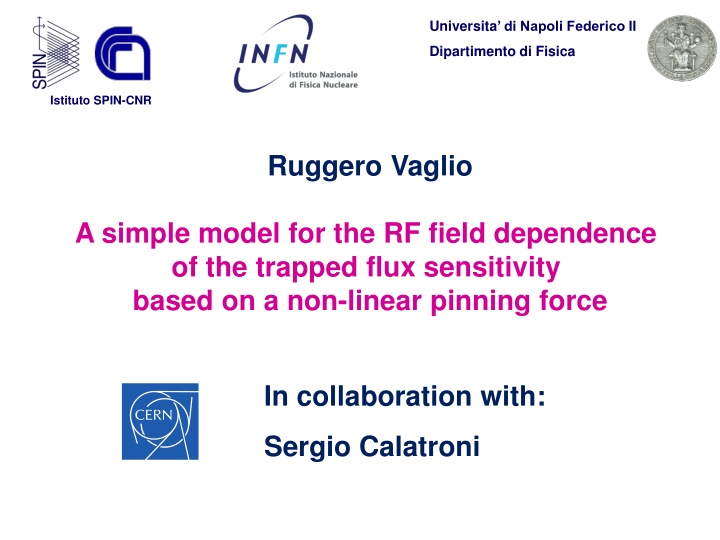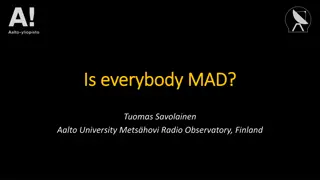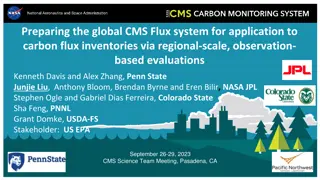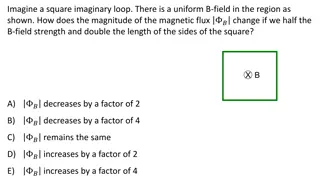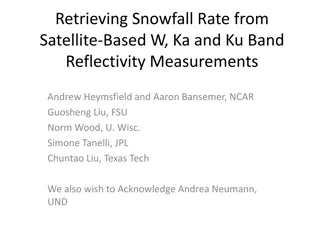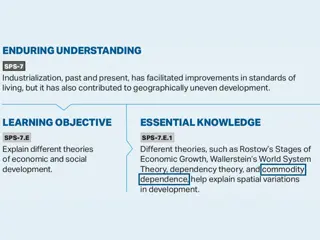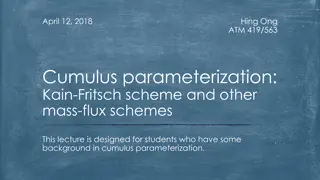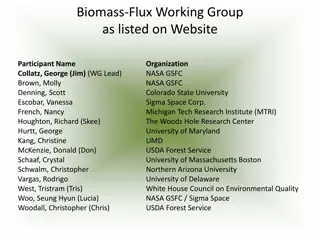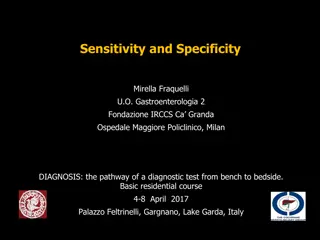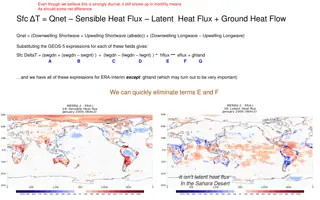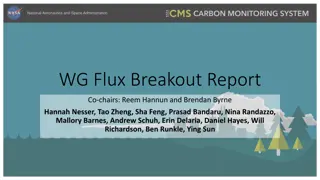A Simple Model for RF Field Dependence of Trapped Flux Sensitivity
The improvement of SRF cavities has led to research on trapped magnetic flux effects and surface resistance. Explore the linear dependence of flux sensitivity across different cavity shapes and frequencies. Discover models like Gittleman and Rosenblum's surface impedance model. Gain insights into the relationship between surface resistance and trapped flux. Collaborate with experts like Ruggero Vaglio and Sergio Calatroni in this field of study.
Download Presentation

Please find below an Image/Link to download the presentation.
The content on the website is provided AS IS for your information and personal use only. It may not be sold, licensed, or shared on other websites without obtaining consent from the author.If you encounter any issues during the download, it is possible that the publisher has removed the file from their server.
You are allowed to download the files provided on this website for personal or commercial use, subject to the condition that they are used lawfully. All files are the property of their respective owners.
The content on the website is provided AS IS for your information and personal use only. It may not be sold, licensed, or shared on other websites without obtaining consent from the author.
E N D
Presentation Transcript
Universita di Napoli Federico II Dipartimento di Fisica Istituto SPIN-CNR Ruggero Vaglio A simple model for the RF field dependence of the trapped flux sensitivity based on a non-linear pinning force In collaboration with: Sergio Calatroni
The improvement of SRF cavities has recently motivated a renewed research effort on the effect of trapped magnetic flux on the surface resistance. The relevant parameter is the trapped flux sensitivity defined as the ratio of the surface resistance due to trapped flux and the trapped magnetic field. 50 40 C. Benvenuti, S. Calatroni, I.E. Campisi, P. Darriulat, M.A. Peck, R. Russo and A-M Valente, Study of the surface resistance of superconducting niobium films at 1.5 GHz , Physica C 316 (1999) 153-188 30 Rfl/ Bext[n /G] 20 10 0 0 5 10 15 20 25 30 Brf[mT] A linear dependence of the flux sensitivity S is generally experimentally observed, at least at low rf field amplitude R B fl = = + 1 fl o fl ( ) S R R B rfo o
A linear dependence of the flux sensitivity is generally experimentally observed, for many different cavities shape and operating frequency Rflo[n /G] Rfl1[n /(G mT)] Author Frequency [MHz] 91 / 160 / 290 3.5 / 9.5 / 28 0.35 / 0.55 / 0.9 Piosczyk [1] Arnolds-Mayer [2] 500 150 5 Checchin [3] 650 / 1300 / 2600 / 3900 700 / 1000 / 1500 / 1900 1.6 / 2.6 / 6.1 / 7.4 Miyazaki [4] 101 3.2 0.32 Benvenuti [5] 1500 3.3 / 56 0.91 / 4.5 1. B. Piosczyk, P. Kneisel, O. Stoltz, J. Halbritter, "Investigation of Additional Losses in Superconducting Niobium Cavities due to Frozen-in Flux", IEEE Trans. Nucl. Sci. 20 (1973) 108-112 2. G. Arnolds-Mayer and W. Weingarten, Comparative Measurements on Niobium Sheet and Sputter Coated Cavities , IEEE Trans. Mag. 23 (1987) 1620-1623. 3. M. Checchin, M. Martinello, A. Grassellino, S. Aderhold, S. K. Chandrasekaran, O. S. Melnychuk, S. Posen, A. Romanenko, and D. A. Sergatskov, Frequency dependence of trapped flux sensitivity in SRF cavities , Appl. Phys. Lett. 112, 072601 (2018) 4. H. Padamsee, J. Knobloch and T. Hays, RF Superconductivity for Accelerators , John Wiley & Sons, New York, 1998, ISBN 978- 0471154327 5. C. Benvenuti, S. Calatroni, P. Darriulat, M.A. Peck and A-M Valente, Fluxon pinning in niobium films , Physica C 351 (2001) 429- 437.
The first model describing the surface impedance due to flux flow is due to Gittleman and Rosenblum (GL, Phys Rev. Lett. 16, 734, 1966) 1 = 2 ( ) U x kx 2 y d<< , z x = n B o o x = + + = = v f = ma f f f ; ; f J f kx L p L rf o p (all quoted forces are per unit lenght) ( ) v t + = ( ) sin kx t J t rfo o T 1 T = ( ) t ( ) v t dt P n d J s o rf 0
+ 2 R B = o fl n R + 2 1 2 B B 2 2 o = = 2 rfo P R H o R R 2 c s fl fl n 2 2 o = 1 fl 2 c 0 R k = o depinning frequency B B = o R R this result represents the so called static model o fl n 2 c that well describes the experimental results for bulk SRF in that regime ( ) n R = o n 2
Model evolutions - Keeping the GR approach, if the condition d<< , is removed, one can calculate the average resistivity due to flux oscillations : E J + 2 vB J B B rfL = = = + o o o i fl n + 2 2 o 2 2 o 2 rf rf c many authors (es. Calatroni, Vaglio IEEE TAS 27 2017) = = + Re Re (1 ) R Z R i sf sf n fl - A further improvement is to consider a non uniform Lorentz force along the z direction, and an angle between field and current : + = /sin z v kx J e (Checchin et al SUST 30 2017) o rf - It is also possible to consider non-rigid fluxons: (Gurevitch, Ciovati PRB 87 2013) In all cases Rfl is independent of Brfo , as expected from first principles for linear harmonic oscillations
Proposed non-linear model (simple extension of the GL approach) S. Calatroni and R.Vaglio, submitted PRE, Arxiv 1810.00540 1 2 1 3 = 2 3 ( ) U x kx x = + pf kx x x ox k = ox k + = x kx x x J Duffing approximation = 1 rf o rfo o J k = = + ) sin( 2 o ( ) v t sin sin( ) sin( ) x t x t x t t o g = t / o with + (as in the linear case !) J rfo o = x o 2 2 o
T 1 T = = ( ) t ( ) v t dt P n d J s o rf 0 2 rfo 2 o T T nd J 1 T 1 T 0 = + 2 sin sin sin( ) tdt d J x t t dt o o rfo o 0 1 T 0 T 2 o T d J x 0 o o rfo ) sin( sin sin( ) t t t dt k T T 1 T 1 1 2 1 T 1 2 0 T 0 t dt = = 2 sin ; sin sin( ) cos t t dt 4 ) sin( = sin sin( ) cos t t t dt 3 2 o 2 rfo 2 o 2 rfo nd J nd J + 2 o + 2 1 2 4 x k = + o P ( ) s 2 2 o 3 2 2 o B = = 2; o c H dJ rfo rfo n
+ 2 o 2 1 2 8 3 1 2 B B = + = 2 rfo 2 rfo 1 o P R H R H s n fl 2 2 o 2 2 c B B 1 x k R 2 o 8 3 rfo = = ( ) o n = + ( ) (0) 1 R B R k fl rfo fl 2 + 2 2 o 2 o c R B fl = = + 1 fl o fl ( ) S R R B rfo o + R B 2 R B = 0 fl n R 2 2 o 2 c 8 3 2 o 1 = 1 fl o fl n R R 2 k + 2 2 o 2 o c
Validity limits 50 C. Benvenuti, S. Calatroni, I.E. Campisi, P. Darriulat, M.A. Peck, R. Russo and A-M Valente, Study of the surface resistance of superconducting niobium films at 1.5 GHz , Physica C 316 (1999) 153-188 40 30 Rfl/ Bext[n /G] 20 0 10 0 0 5 10 15 20 25 30 Brf[mT] 2 o 8 3 1 max rf = + ( ) 2 (0) R B R 2 ( ) (0) 1 R B R 0 fl fl fl rfo fl 2 max rf 6 B mT 0
1 fl 0 fl R Model vs experimental results : vs correlation R 1.5 C. Benvenuti, S. Calatroni, I.E. Campisi, P. Darriulat, M.A. Peck, R. Russo and A-M Valente, Study of the surface resistance of superconducting niobium films at 1.5 GHz , Physica C 316 (1999) 153-188 1[n /(G mT)] R 1.0 0.5 fl 0 0.0 0 1 2 3 4 5 6 7 8 0[n /G] fl R = k 0 fl 0( , fl ) R R 2 R B n 0 fl n R 2 o 2 c In the model the relation is strictly linear only if the change is due to a change in the pinning force k 2 o 8 R 0 fl R 1 fl o fl n R R 2 3 k B 2 o o c
Model vs experimental results : frequency dependence B. Piosczyk, P. Kneisel, O. Stoltz, J. Halbritter, IEEE Trans. Nucl. Sci. 20 (1973) 108-112 10 8 1[n /(G mT)] R 6 M. Checchin, M. Martinello, A. Grassellino, S. Aderhold, S. K. Chandrasekaran, O. S. Melnychuk, S. Posen, A. Romanenko, and D. A. Sergatskov, Appl. Phys. Lett. 112, 072601 (2018) 4 fl 2 0 0 1 2 3 4 5 Frequency [GHz] (a different behavior is predicted for ) modelresult for 0 0 2 n 8 1 6 R 1 fl R 2 c k B 2 o o
Conclusions : - Linear GL-type approach to the flux flow dissipation give a rf field amplitude (Brfo)independent surface resistance Rfl - Experiments clearly show a linear dependence of Rfl on Brfo, at least at low fields - reproduces the correct Rfl linear dependence on Brfo A simple non-linear extension of the GL-type approach The observed strong correlation between Rofl and R1fl - naturally emerges from the introduced non-linear model The model predicts the linear frequency dependence of R1fl , - observed in the experiments, but only in the limit < o - dissipation complex phenomena, but can give useful hints towards the developement of a more complete treatment. The model is far too semplified to fully account for the flux flow
